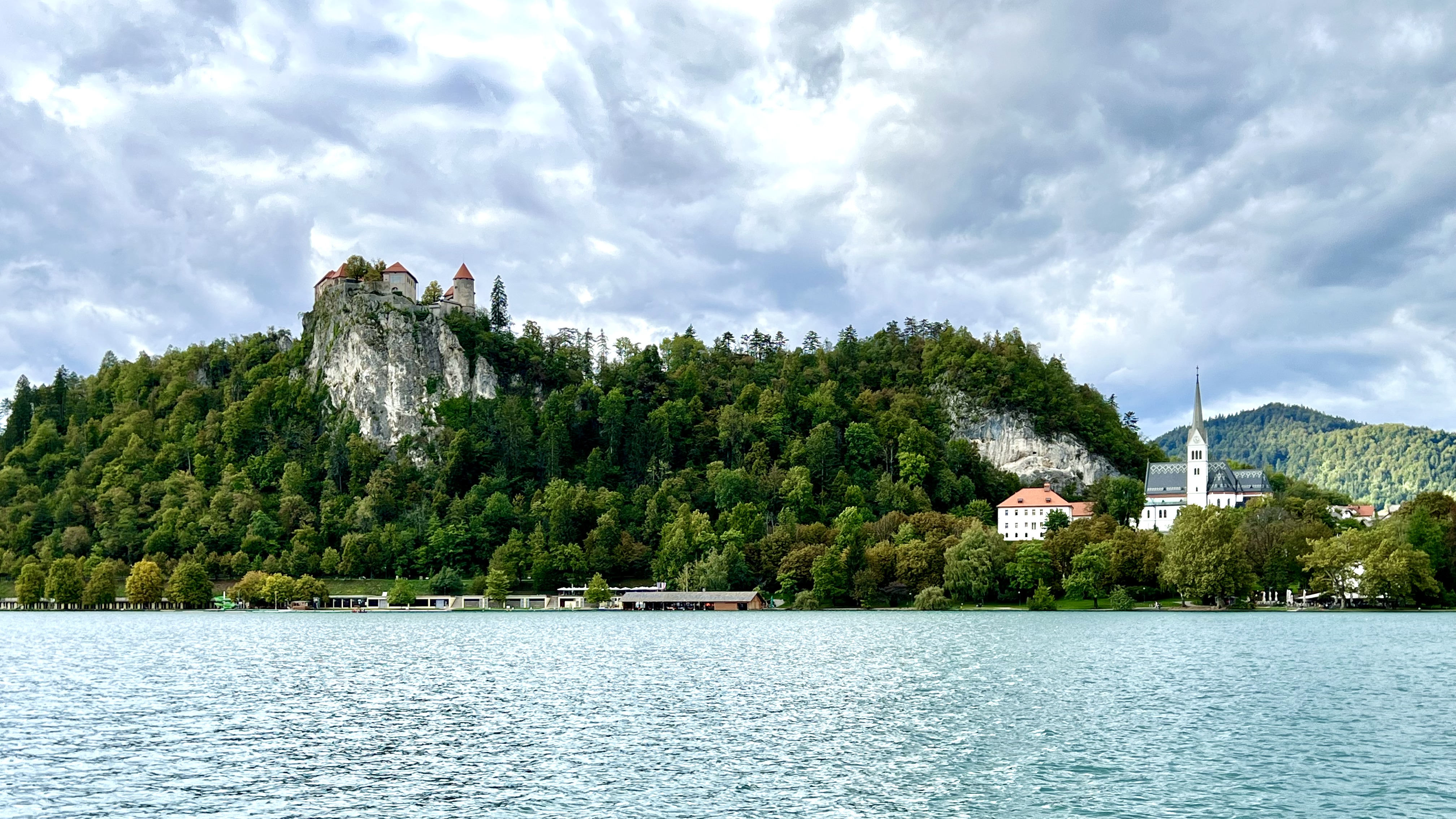
Table of Contents
You don’t have to be a romantic to fall for the Alpine charms of Slovenia’s Lake Bled.
Even the most travel jaded—and there aren’t too many of those following the worldwide Covid quarantines—will appreciate the storybook setting and lost-in-time vibe of the ancient red-turreted castle and old-world churches on the lake.
Date of Visit: September 19 and 20, 2022—Lake Bled, Slovenia
Perched atop a craggy cliff above a turquoise lake, the 1,000-year-old castle is a reminder that the Grimm fairy tales took their inspiration from real-life. And while there is a local tale of dwarfs, fairies, a golden-horned goat, and even a lake monster, the Brothers Grimm did not write this story.
A Waterfront Masterpiece
My husband, Chris, and I took in this surreal masterpiece of nature and human toil from one of Grand Hotel Toplice’s balconies. We had checked in for two nights after arriving by car from Zagreb via Ljubljana.
Our Room Looked Out to the Road
The room we had booked had a view of the road, which was unfortunate because this small, iconic luxury hotel offers one of the most breathtaking panoramic views of the lake.
We would later decide it was worth the splurge to upgrade to a large room with a view. Room 414 was perfect.
The upgrade cost us less than a one-night stay at a Motel 6 in the U.S.
You can easily book your room through our affiliate partner, Booking.com.
Disclosure: Travelthefourcorners.com participates in the Travelpayouts.com Affiliate Program. If you book through Booking.com or Viator tours, I will earn a commission. This commission helps me keep Travel The Four Corners’ website running, and it doesn’t cost you anything extra.
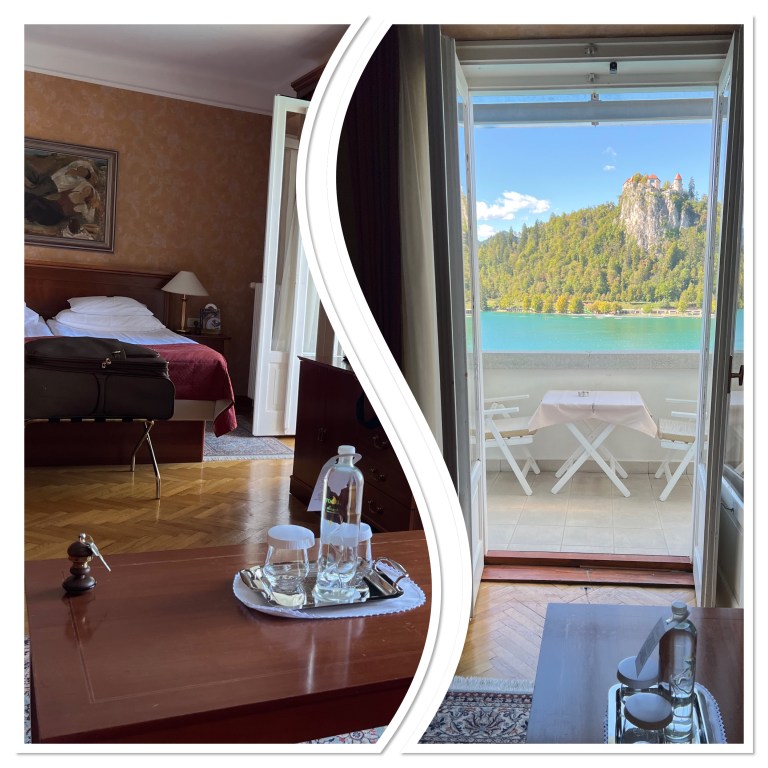
Our View from the Hotel Balcony
Across the water, the ancient castle looked impenetrable. A forest of emerald-green trees partially covered the sheer limestone cliffs on three sides. A moat lapped against the fourth side long ago, and a drawbridge was the only way in.
While it may once have kept barbarian invaders at bay, today, a paved road and a forested path lead tourists to the castle entrance. For €15 per person, hordes of tourists (descendants of some of those barbarian raiding parties, no doubt) visit daily to walk through the museum, sample the four- to six-course menus, and sip fine wines in the medieval wine cellar.
View of the Pilgrimage Church of the Assumption of Mary
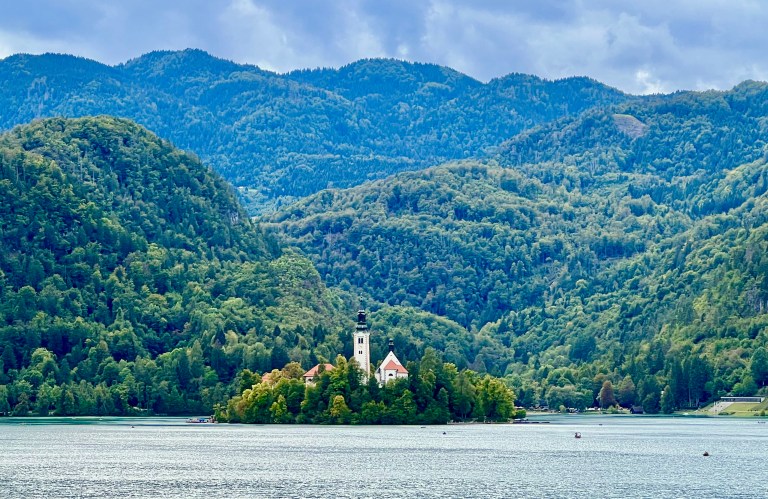
Vying for our attention at the lake’s far end was the 17th-century Pilgrimage Church of the Assumption of Mary. Its Bell Tower and red-pitched roofs peeked above an emerald islet. In the background, the Julian Alps framed lush green hills that rolled down to the water’s edge.
I could make out Mt. Triglav’s snowy summit from my vantage point. There’s a local saying about this “three-headed” 9,395 ft mountain, Slovenia’s tallest:
“If you haven’t climbed it at least once, then you are not a true Slovenian.”
It’s an apt saying for a nation known for its love of nature.
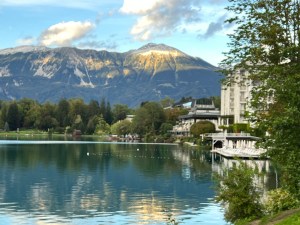
Behind us, the Karawanks mountain range towered above Old Town Bled. It had rained for the past few days, as it had during our stay in Zagreb, so there was snow on the highest peaks. Austria lay on the other side, its bloated borders redrawn after World War I.
A Webcam for Armchair Travelers
If you want to see for yourself, look through the moving lens of this streaming Webcam. It’s a more distant view of the lake and castle streamed from the Rikli Balance Hotel on the hill behind.
A Poet in Carniola
Slovenia’s greatest poet, France Prešeren (1800-1849), perhaps said it the best:
“No, Carniola has no prettier scene than this, resembling paradise serene.”
Carniola was a long-ago state ruled by the Habsburg monarchy within the Holy Roman Empire. Before the Napoleonic Wars, it cut across a swathe of Slovenia that encompassed Lake Bled and the nearby Alpine village of Vrba, where the poet was born. Prešeren’s childhood home in Vrba is now a museum.
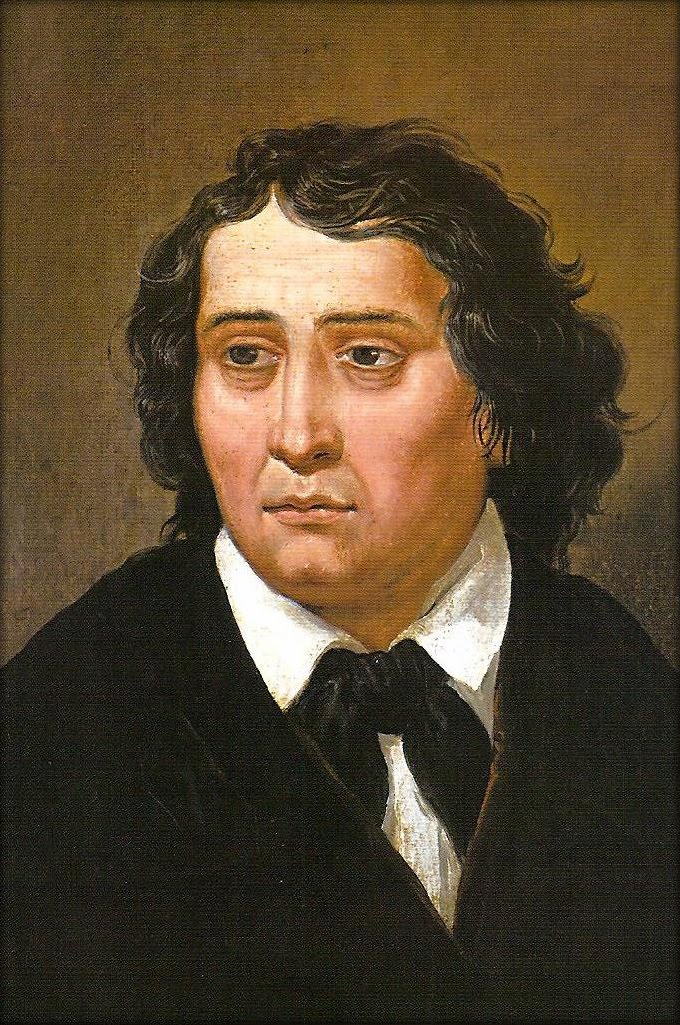
Things To Do Around Lake Bled
With such unspoiled beauty, it is little wonder that Lake Bled is Slovenia’s most popular tourist destination. People come here for a wide selection of outdoor activities too.
Activities for Thrill Seekers
There are nearby ski resorts and plenty of outdoor activities for visitors who plan an extra day or two. Thrill seekers can go white water rafting on the Soča River, rock climbing, canyoning, mountain biking, and paragliding.
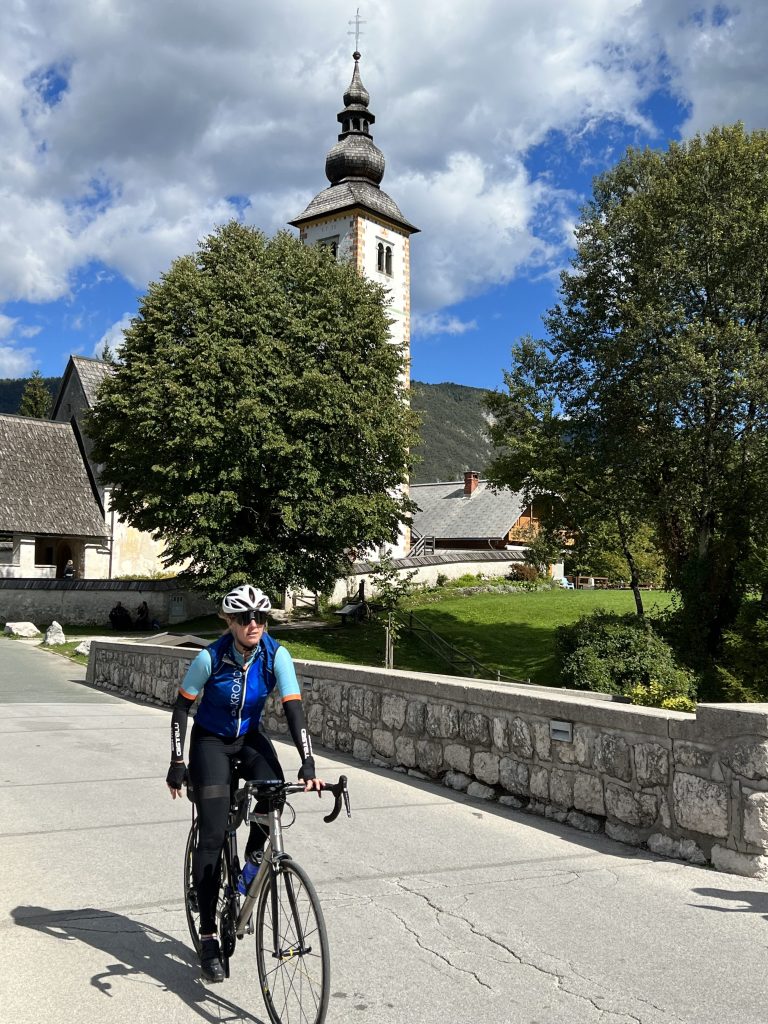
Other Activities Include Hiking, Golf and Horse-back Riding
There are many hiking trails, plenty of swimming areas (“lidos”) in Lake Bled and beyond, and places to golf, and rent bikes, e-bikes, and horses. Others come to taste the delicious Slovenian wines and festivals such as Bled Days and its Festival of Lights in late July.
Thermal Spas
Bled’s thermal and mineral springs have been a health tourism destination since the mid-1800s. Today there are 10+ wellness centers and spas in the area. One of the best is Wellness Živa at The Rikli Balance Hotel.
For visual inspiration, here is a video from Turizem Bled.
Sightseeing and Hiking in the Julian Alps: A Short Drive
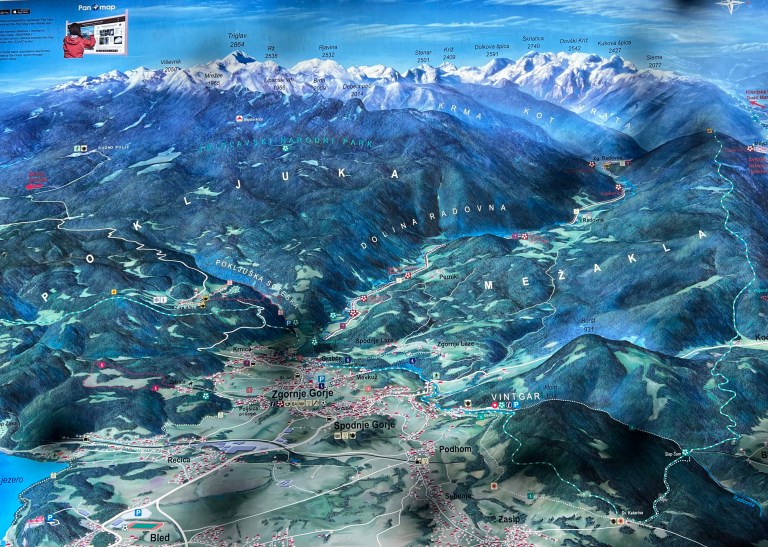
Lake Bled is a good starting point for visiting Vintgar Gorge and Lake Bohinj or driving to Triglav National Park to see striking views of the Julian Alps and hike miles of trails through beech forests with gushing waterfalls.
To avoid the lines, it’s wise to book Vintgar Gorge online in advance. Viator offers tours and tickets to Vintgar Gorge and other nearby sites.
The "Pletna" Tradition
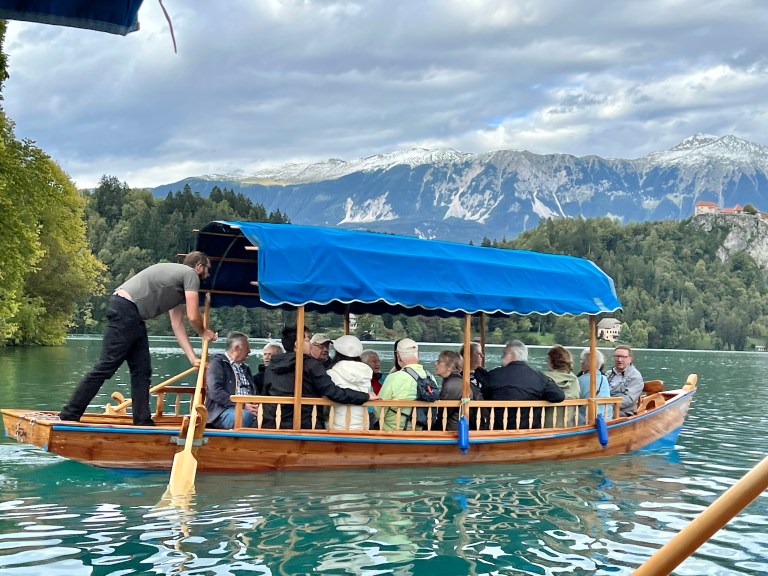
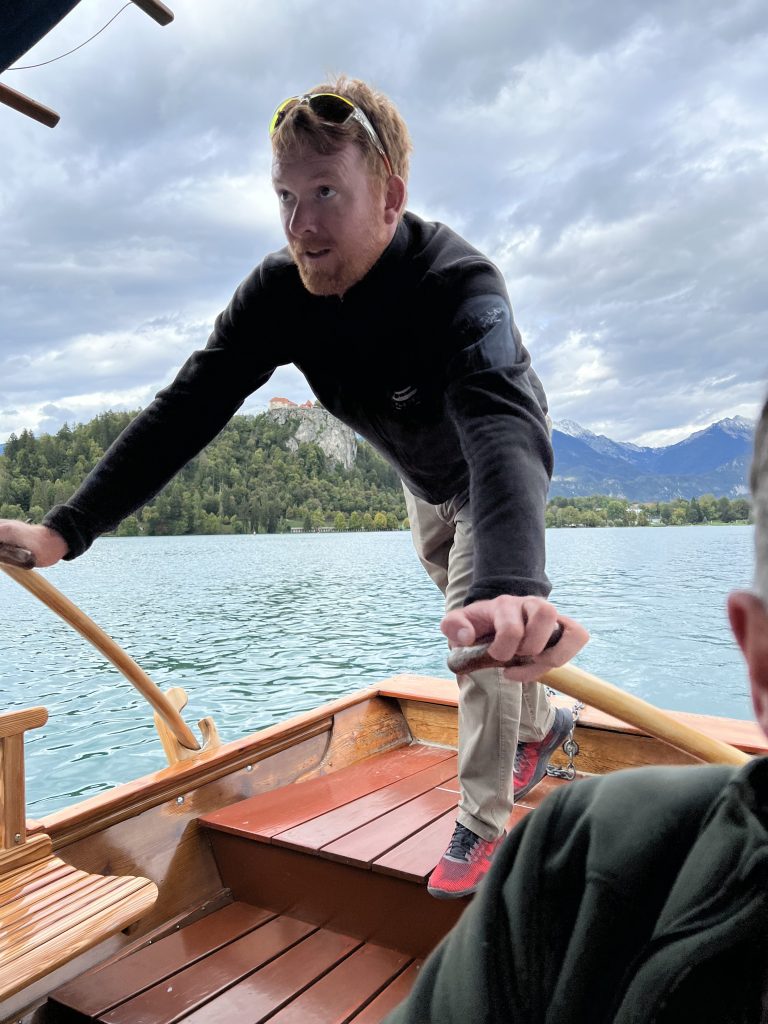
It's a Small World
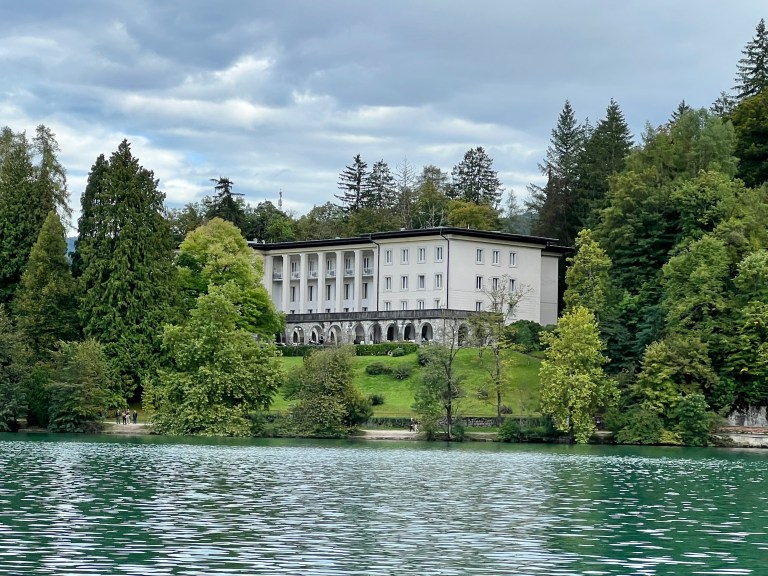
Tito’s Summer Villa
World Leaders Visited Tito at Lake Bled
During Tito’s rule (1945-1980), a parade of world leaders and celebrities visited him in Lake Bled. He entertained the likes of Emperor Akihito of Japan, King Hussein of Jordan, Indira Gandhi, North Korea’s Kim Il-Sung, and the Soviet Union’s Nikita Khrushchev.
If those walls could talk, right? But can you imagine sleeping in their rooms?
Well, you can do just that. In 1984 after Tito’s passing, this historic building was converted into the Vila Bled hotel. It was closed for a few years but is now owned and operated by the government of Slovenia.
Café Belvedere
On the hotel grounds, another building of note sits on high pillars with a birds-eye view of the island church. Café Belvedere was once the waiting room for King Alexander’s visitors. Today it is part of Vila Bled, serving coffee, desserts, and the famous Bled Cream Cake.
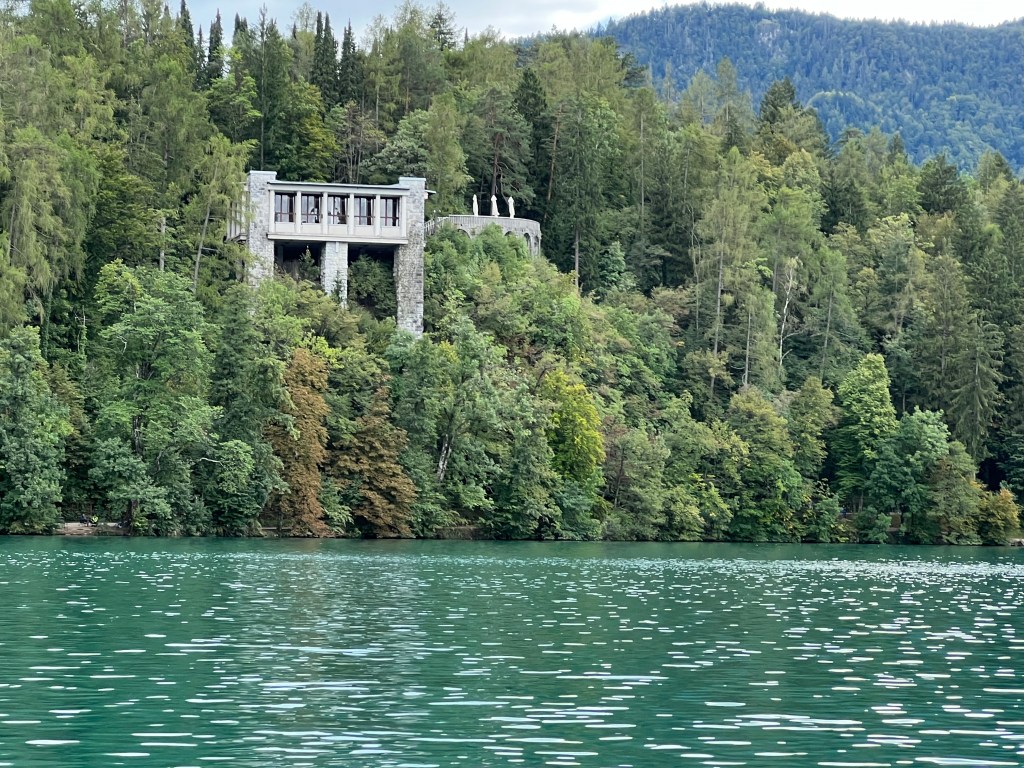
Pilgrimage Church of the Assumption of Mary
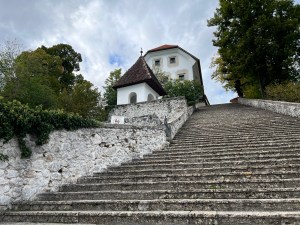
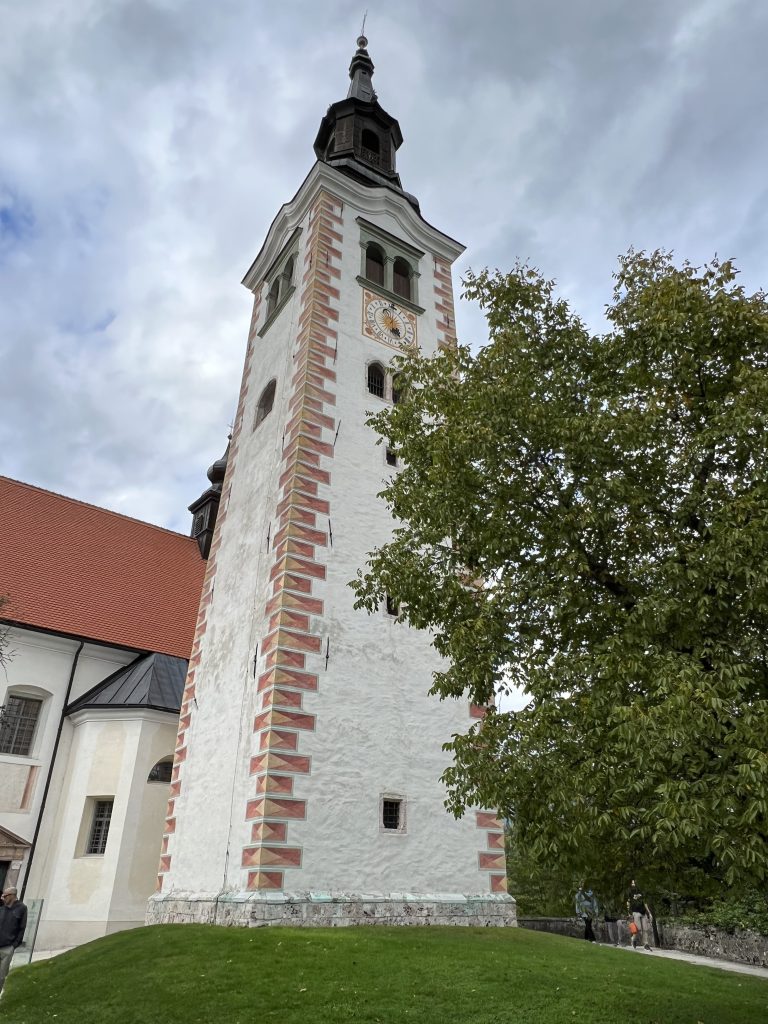
Under Alex’s sheer might, we reached the island in 20 minutes. We were given a half hour to look around, which, as it turns out, is plenty to see the Pilgrimage Church, its freestanding Bell Tower, and to walk the wooded lakeside path around the tiny island.
Be warned. Depending on how fit you are, an oxygen tank may be necessary. The only way to get to the church is to climb 99-stone steps from the dock.
Grooms Beware
Slovenian tradition calls for grooms to carry their brides to the top as a sign that they are fit for marriage. Hopefully, these traditionalists invest in a gym membership or climb Mt. Triglav several times to knock themselves into shape beforehand.
Tip: Married couples would be wise not to renew their vows on this trip.
From Paganism to Christianity
Centuries before the first Christians arrived, the pagans erected an altar to pay homage to Živa, the goddess of love and fertility. Nothing remains of the altar or the first brick Christian church built in 1142. And only a few artifacts remain of the Gothic-style church built in the mid-1400s. The second church suffered severe damage in the 1511 earthquake. In its place is the 17th Century Baroque-style church you see today.
A viewing window in the floor below the Church bell rope grants an eerie peek at 124 medieval graves.
A few large frescoes saved from the ruins of the Gothic church hang near the altar. One is unusual for its depiction of the circumcision of Christ.
The Wishing Bell
You may pull the bell’s rope if you are superstitious or want to cover your bases like many of us do when we knock on wood. The “lady from the lake” will grant your wish if it rings three times with one tug.
A boy of about eight made a gallant effort when we were there. He swung back and forth, legs wriggling. The bell remained silent under his 60lb weight. Finally, with his father’s help, they managed one clang. Many have tried and failed. Prince Charles couldn’t do it either when he was here.
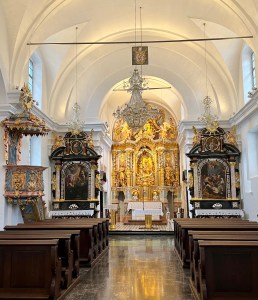
The Bell Tower
If you are a glutton for punishment, you can climb another 91 steps up the Bell Tower if inclined. Chris and I considered it, but a couple descended and told us it was a nice view but no big deal. We gave it a pass, but in hindsight, I wish I had gone up to see that view. Here’s All You Need to Know to Visit the Church on Bled Island.
Bled Castle was on the agenda for the next day, September 20. From there, we would drive to Bohinj Lake and then to Vogel mountain in Triglav National Park. A cable car would whisk us to the top to get a nosebleed view of the lake.
Bled Castle
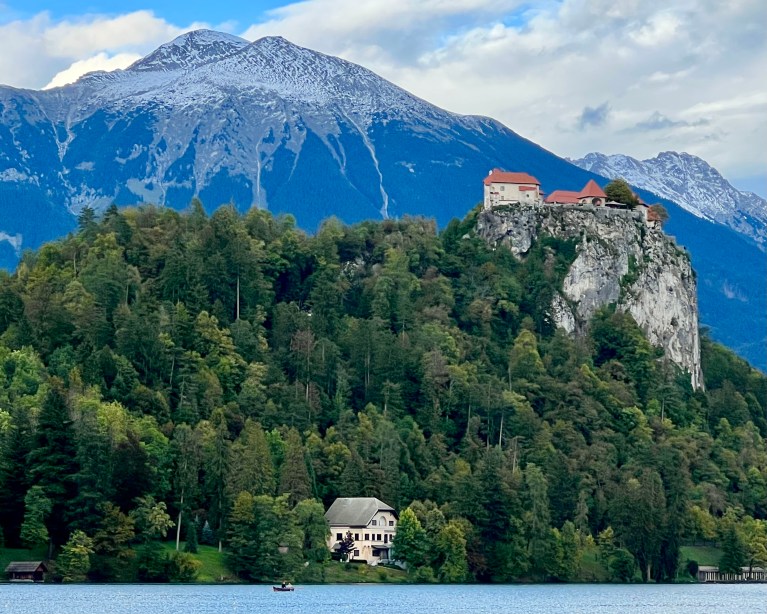
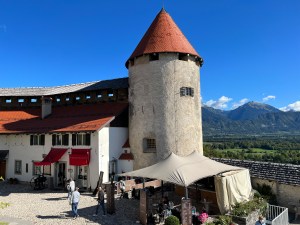
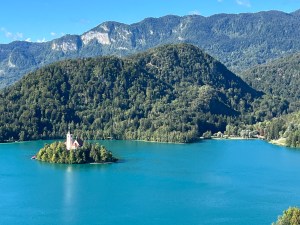
The Museum
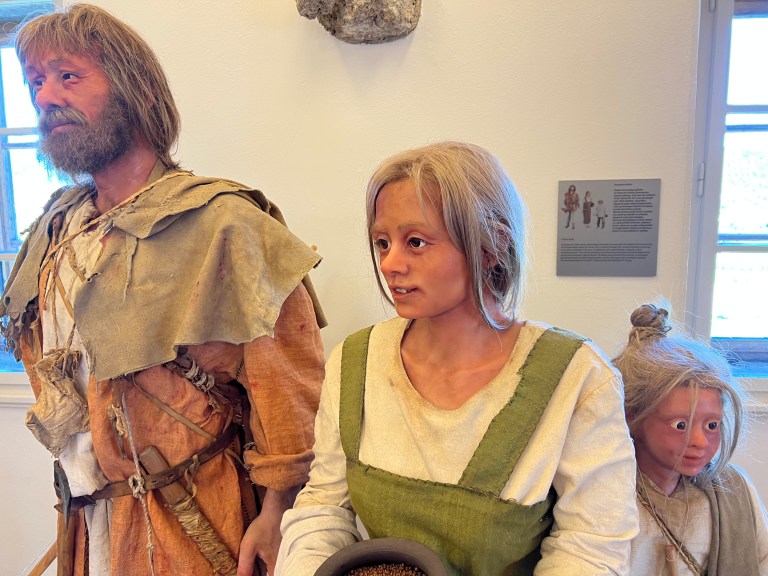
Elk or Moose?
A photo of what looked like a North American moose confused me. It stood across from a display case featuring antlers and bones. The museum identified the remains as belonging to a long-deceased elk. So why was there a photo of a moose?
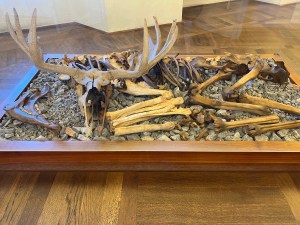
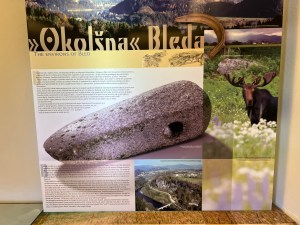
Did the curator get mixed up? The photo said there hadn’t been an Alces alces elk roaming about Slovenia since Roman times.
I decided to do further research, which means I googled Alces alces. That’s how I learned Slovenia’s Alces alces elk are what we call moose in North America. Europe calls them Eurasian Elk.
In Europe, the Alces alces elk no longer live in Slovenia. Today they exist only in Scandinavia, Russia, and the Baltic region.
Mystery solved. It’s funny the things that you get stuck on sometimes.
By the way, The Bled Culture Institute has an excellent audio tour of the castle.
Highlights include the chapel, printing press, wine cellar, and restaurant.
The Chapel
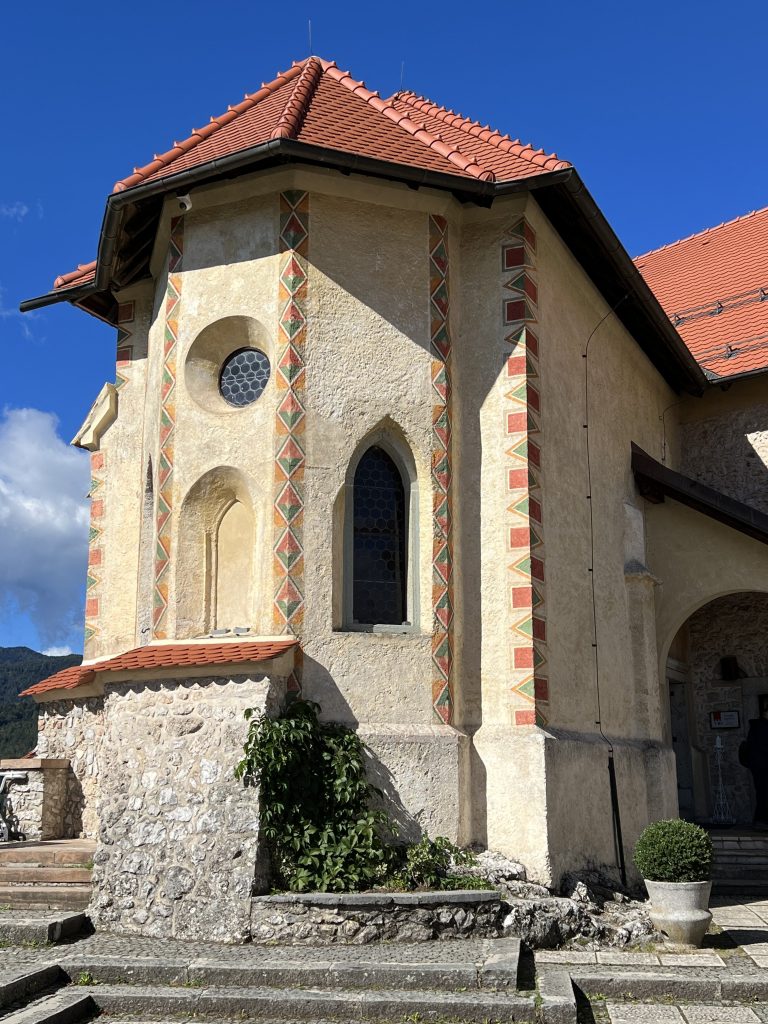
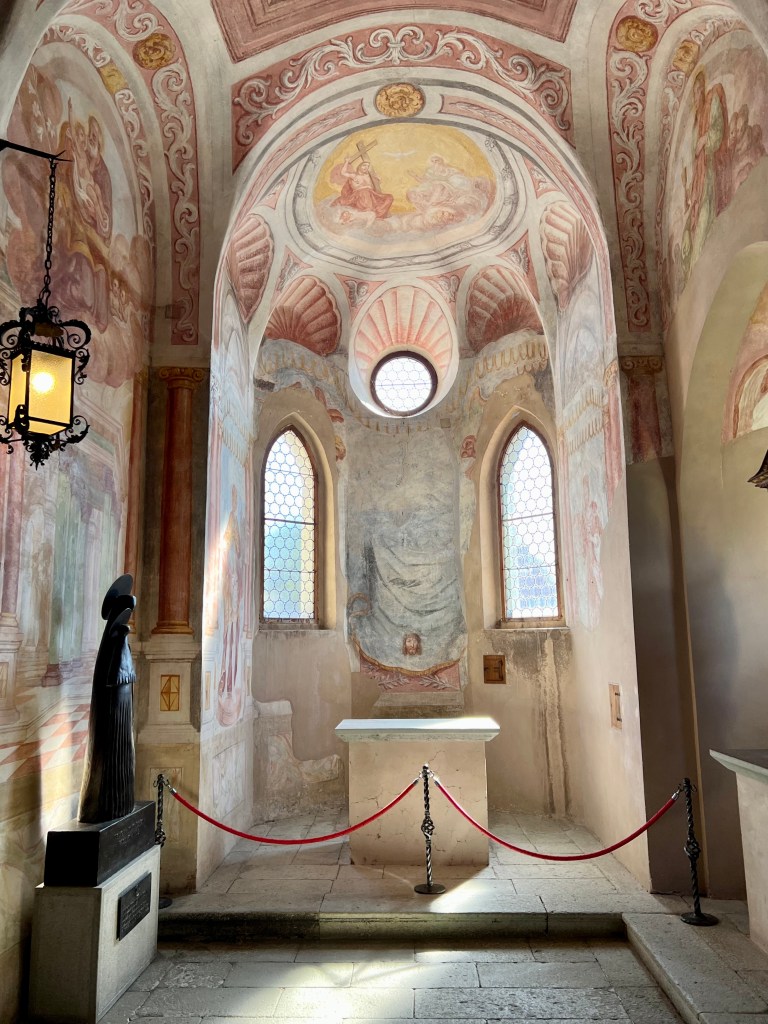
The Gothic chapel was built in the 16th century and renovated in about 1700. Inside it is painted with frescoes depicting its patrons.
The Printing Press
Bled Castle has a replica of a Gutenberg printing press for a reason. An important figure in the Slovenian Protestant Reform movement, Primož Trubar, visited a leaseholder at the castle in 1561. Trubar wrote the first two books ever written in Slovene. A Gutenberg wooden press printed them. Visitors can try their hand at printing on the machine.
The Wine Cellar
The wine cellar offers 20 Vina Dornberg wines for tasting at the medieval castle. Visitors can fill, cork, and wax their bottles; all aged in oak barrels. It’s a special treat to see the opening of sparkling wine with a sword.
Bled Castle Restaurant
This is a highly-rated restaurant with spectacular views, as you might imagine. You can make reservations for a four- to six-course tasting menu of local and regional dishes. The menu changes every three months.
A Quick History Lesson -- Oh No!

Bear with me. There are a few things you should know before setting foot in the castle.
Bled Castle was the first castle ever mentioned in a written document. In 1011 AD, the Holy Roman Emperor deeded the castle to the Diocese of Brixen. Based on that written record, it is the oldest castle in Slovenia.
The deed was likely a reward to the Diocese of Brixen. It supported the Holy Roman Empire through turbulent times. The Franks had subjugated the local population in Slovenia for 200 years. But, raids by the Magyar (Hungarian tribes) were still troublesome. In addition, there was danger from marauding bands and common thievery.
The Brixen bishops lived 186 miles away in northern Italy. And aside from a few visits that took four days by horse, they left Bled Castle in the hands of trusted ministers. Those ministers dealt with an earthquake in 1511 and Peasant Revolts in 1515.
Conquerers and Owners
France claimed Bled Castle as part of Napoleon’s Illyrian Provinces from 1809-1813. The Diocese of Brixen reclaimed it in 1838 but had to sell it. The property was too expensive to maintain after the feudal system ended.
Over the years, there have been many private owners of the castle. One even dreamed of converting it into a hotel. The Slovenian government owns it today, and the Cultural Institute of Bled manages it.
For more history and information, see Bled Culture Institute.
Bohinj Lake and St. John The Baptist Church
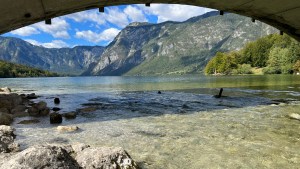
Chris and I didn’t venture into the church, but having read a visitor’s post on TripAdvisor; I now think we should have. The post mentions the depiction of toothy angels, and several have goiters. I have never seen such unusual religious depictions, but I haven’t seen many Gothic churches either.
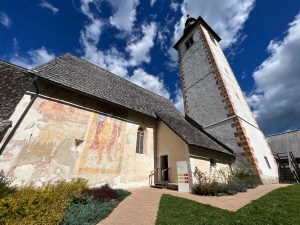
Left: The Sava Bohinjka River rushes under a stone bridge with an expansive view of Bohinj Lake from underneath.
Right: The medieval St. John the Baptist Church and its onion-domed Bell Tower in Lake Bohinj.
The Myth of Goldenhorn
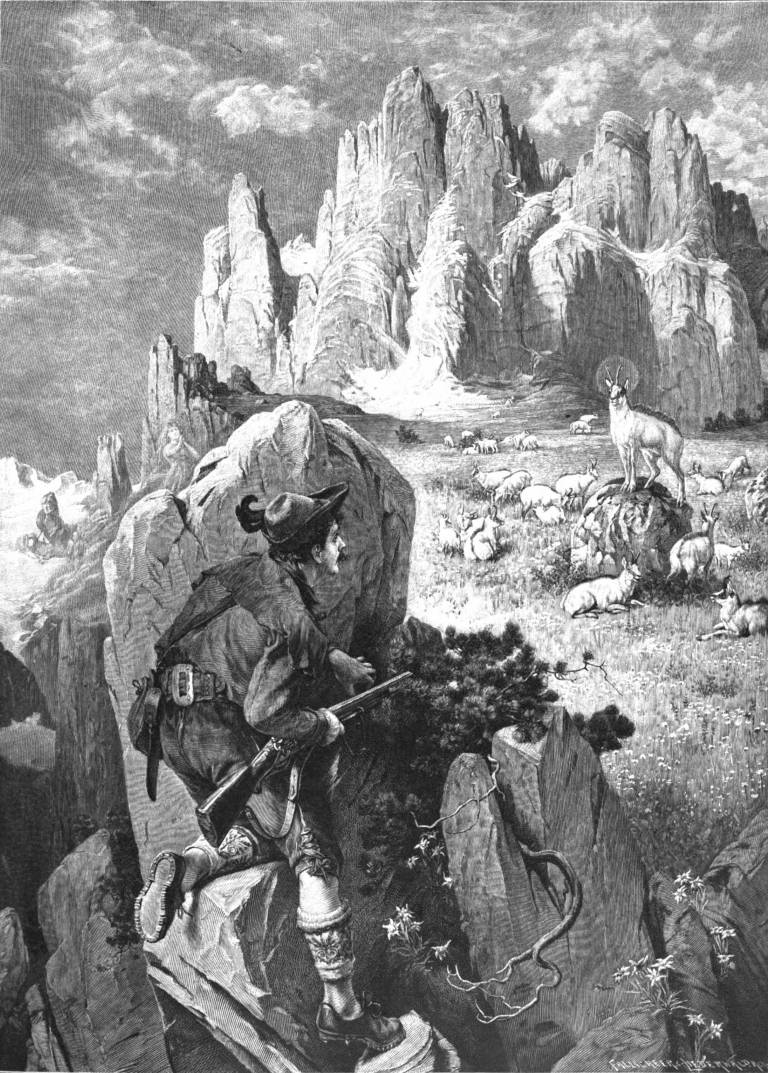
A statue dedicated to “Zlatorog,” a magical chamois with golden horns, stands on a rock at the lake. The legend of this mythical god passed from one generation to another.
In 1868 it was finally committed to print in an article written by a Carniolan politician.
Chamois are native to Slovenia and to Triglav National Park too. Although they lack the golden horns of Zlatorog, they are still hunted in parts of Slovenia.
The myth has all the makings of a good yarn. It is about a young hunter who chases a white chamois with gold horns to become wealthy to win the affection of a maiden.
A multi-headed snake guards treasure within the mountains. In addition, there are fairies, a magical Triglav flower, and a villainous character. The tale takes place in the Julian Alps.
Feel free to read more about The Goldenhorn in Slovenian Folk Belief Tradition before we continue to our next stop at Vogel Mountain.
Vogel Mountain
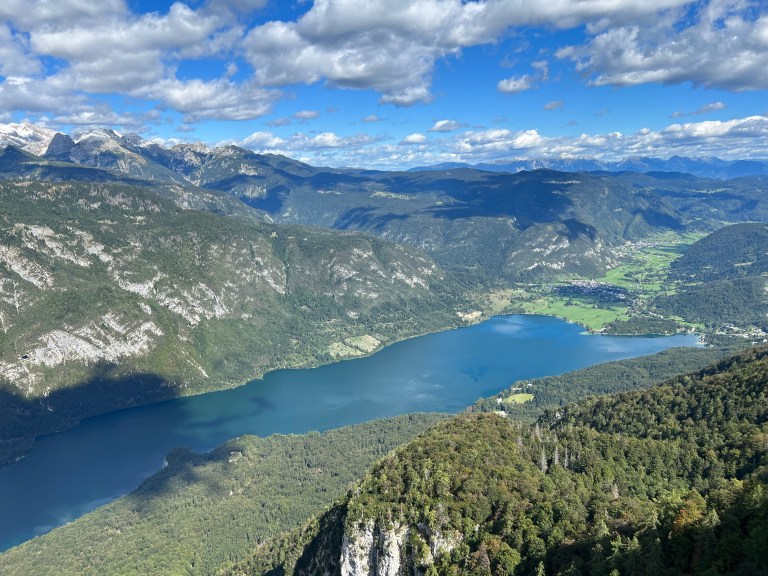
Vogel Mountain is one of the largest ski resorts in Slovenia. Year-round it offers a spectacular view of the Julian Alps and Bohinj Lake from its 6,200 ft crest.
Every 30 minutes, a cable car whisks sightseers to the top to snap photos. Afterward, they can grab a bite at the restaurant or its outside snack bar. Our gondola was packed, and although we were stuck in the middle, we still had amazing views of the steep ascent.
Once at the top, we took vertigo-inducing photos from the viewing platform before joining the throng gathered at picnic tables on the large wooden deck. Chris ordered a tasty Pivovarna Laško golden lager, and I had a Janževac medium-dry white wine that was my guilty pleasure at 1:30 pm.
“It’s five o’clock somewhere.”
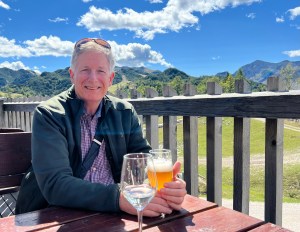
Walking Lake Bled
After we returned to Lake Bled, we took an evening stroll along part of the three-mile path circling the lake.
We walked past St. Martin’s Parish Church, a boat house, a “lido” (a cordoned-off swimming area), and the wooded trail leading up to Bled Castle. There are a handful of villas on the lake, and we wondered who lived in these idyllic spots. Lake Bled has a dreamy, nostalgic feel about it.
I suspect it hasn’t changed much since the turn of the century. The thermal mineral springs brought tourists to the lake in the 1850s. And spa treatments remain popular here. Today, Grand Hotel Toplice boasts a spring-fed pool whose water is changed daily. It turns out that “Toplice” is the Slovenian word for a spa.
A Plaque About Goldenhorn
As we wandered, we came upon a plaque entitled “Don’t Forget The Bled Goldhorn.” Over the centuries, this chamois myth has enjoyed a fair bit of artistic license. This story version mentioned a Lake Monster, tree fairies, and dwarfs. However, the “green” message was clear. Goldhorn (or Goldenhorn) “looked after nature to preserve it nice and clean.”
An Unusual Tribute
Dusk quickly gave way to nightfall, so we turned and walked briskly back to the hotel. Suddenly, we noticed tiny lights flickering in the distance. As our eyes adjusted, we watched men in two rowboats setting candles in eggshells afloat. The lake appeared to be on fire.
Above the lake, Bled Castle was bathed in warm, orange lights. A laser beam projected silhouettes of Queen Elizabeth onto the cliff with images of the crown and the years 1926-2022, marking her birth and death.
A hushed crowd had gathered on the shore to watch the spectacle.
It was then that we realized this display commemorated the Queen’s passing.
How extraordinary that we were in Slovenia watching a commemoration of the reign of Queen Elizabeth II on the day of her state funeral service. After all, Slovenia was on the opposite side of Britain and the U.S. during both World Wars and then spent almost 50 more years under communist rule.
And yet Tito maintained diplomatic relations with the United Kingdom. In 1972, Queen Elizabeth visited Tito in Yugoslavia. Her husband, Prince Philip, the Duke of Edinburgh, attended Tito’s funeral in 1980.
Years after Tito’s death, Prince Charles visited Slovenia in 1998. His trip included the pletna ride to the church on the lake. In 2008, the Queen and Prince Philip visited together. Queen Elizabeth said at the Slovenian State Banquet that year:
“I hope that this visit will demonstrate the importance the United Kingdom attaches to our relationship with Slovenia, as a partner in Europe and an ally in NATO, with whom we share so many common values and aspirations.”
If Tito were alive, he might have approved this laser tribute and raised a glass of his trademark cognac in a toast.
I doubt the Diocese of Brixen and the Maltese patriarch on the pletna ride that day would have done so.
This post is the 4th of my 19-part Balkan series that began with Road Tripping on the Balkan Peninsula in September 2022. There, you will find our itinerary to help you plan your trip.
- Ratings are based on 1) Natural Beauty 2) Unique Activities 3) Old World Charm
This article is the 4th in my 19-part Balkan series, which began with ‘Road Tripping on the Balkan Peninsula’ in September 2023. There, you will find our itinerary to help you plan your trip.

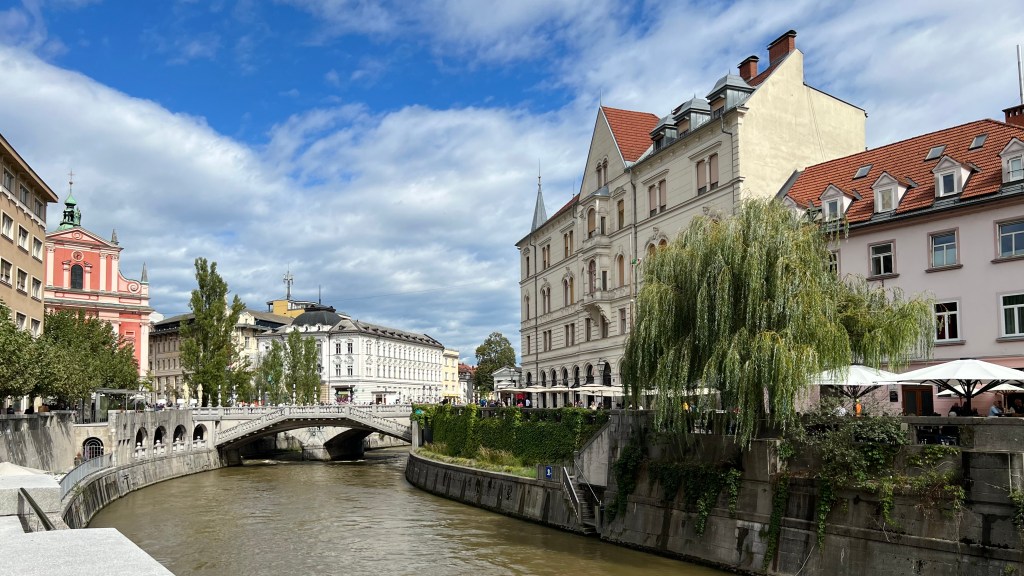
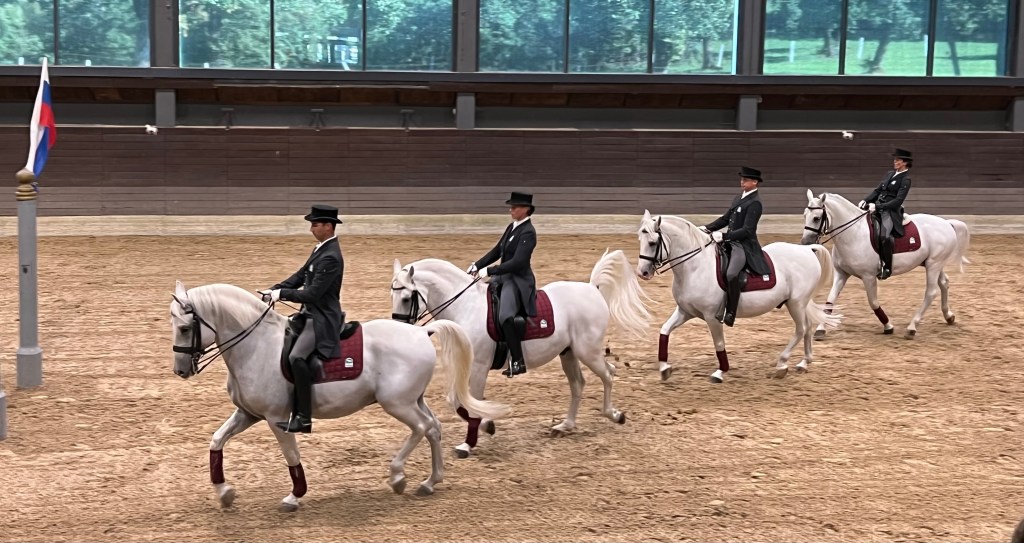










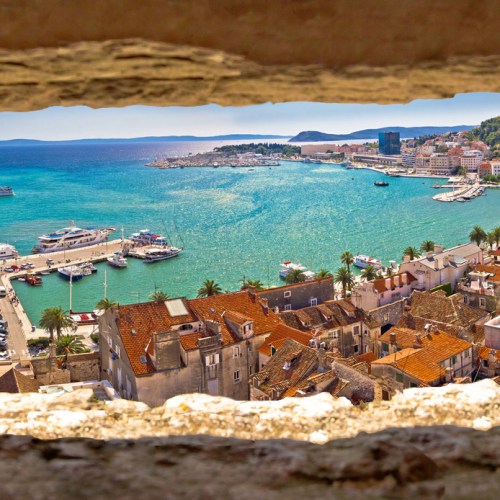
2 Comments
Café Belvedere is great! My husband and I love having coffee and kremšnita (the Bled cream cake) there when we visit the area. And so fascinating to walk through Tito’s old villa, too. There is a haunting painted mural on one of the walls inside reflecting the life of everyday people under that regime. Quite a contrast to how Tito lived and also how he entertained within the villa’s walls.
Thank you for posting about your visit to Café Belvedere aka Tito’s Tea Room. It looked lovely from our pletna, and I would have enjoyed having a coffee and kremšnita like you did on the terrace. I didn’t know much about it until I returned to the States and researched it. When I found out it had been Tito’s villa I was disappointed we didn’t visit. I saw a video of the mural in Rick Steve’s video, and totally agree with you. It’s a very moving piece. I’m glad the Slovenian government owns it again.
Discover more from Travel The Four Corners
Subscribe now to keep reading and get access to the full archive.
Continue reading